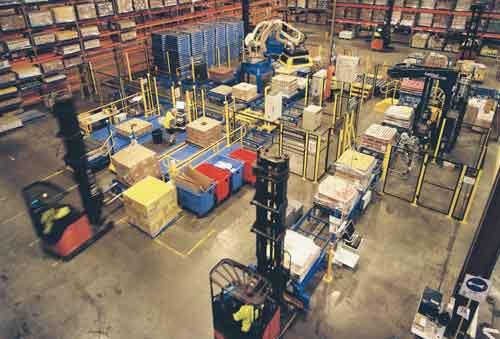The high demand for Nestlé’s leading household brands means most of the DC’s orders – around 80 percent – are distributed as full pallets. Picking the remaining 20 percent of orders – which are distributed in pallet layer and full case quantities – has involved the manual handling of around five million cases per year, creating a significant and ongoing occupational health and safety (OH&S) challenge.
Nestlé’s innovative layer picking solution eliminates the need to manually handle around four million of those cases. The layer picking system achieves very high throughput rates thanks to logistics systems supplier Dematic’s FreePick Maximiser patented software. By cross-matching orders and pairing those with compatible order profiles, FreePick Maximiser enables around 20 percent – in some instances up to 50 percent – of goods for orders to be distributed without them being physically picked.
A safer, smarter solution to picking and building layers
Orders from Nestlé’s SAP warehouse management system are downloaded into Dematic’s PickDirector warehouse control system to initiate picking. Interfacing with FreePick Maximiser, PickDirector orders the stock required for layer picking in the sequence required to fulfil the next wave of orders. This is retrieved from the adjacent bays of reserve storage by RF-directed forklift and loaded onto the induction conveyor spur. As pallets are fed into the layer picker, they are scanned, and the control system directs the operator to remove the required amount of stretchwrapping from the pallet.
The pallet is then conveyed into the layer picker where it will go directly to one of four pick and put locations, or, if it is not immediately required, into one of eight buffer storage locations serviced by an automated pallet cart. While the software requests pallets to arrive at the layer picker in a particular sequence to suit order assembly, the reality is that pallets occasionally turn up out of sequence. The buffer storage locations enable such pallets to be temporarily stored online within the layer picker until required.
As new pallets of stock are fed into the system, the layer picker selects the required layers and transfers the stock to one of four customer order pallets. Any stock remaining on a pallet either forms the basis for another order via the system’s FreePick Maximiser software, or is returned to the adjacent reserve storage bays for use at a later stage.
Building stable rainbow and sandwich pallets to order
With the supply chain running leaner, there is a general trend towards ordering smaller quantities of goods such as layers, rather than full pallets, or cases rather than layers. Many customers also require pallets to be built in a certain way to suit further processing. To maximise pallet building flexibility, the layer picking system has four order picking positions, which enables up to four orders to be picked concurrently. An empty pallet station accommodates the production of multiple layer sandwich pallets.
The four-axis robotic layer picker is equipped with a dual bellows and vacuum-gripping head capable of handling up to 80 percent of Nestlé’s product range, covering a broad range of packaging types from cartons to bags and bottled beverages. When the robot is directed to pick up a layer, the bellows inflate and close around the product creating a seal. The vacuum exerts just enough pressure to pick up the layer, minimising the potential for product damage during handling. The vacuum gripper head offers the maximum versatility in product handling, making it suitable for picking layers from any pallet stacking pattern, even those that have a hole in the middle.
Completed orders are conveyed through the integrated layer picking system being checkweighed, stretchwrapped and labelled on the way, until they exit ready for collection and transport to despatch by forklift. Orders that require further case picks to be added to the layers exit the system, where a barcode label is attached prior to their retrieval by forklift. After the required case picks have been completed using the DC’s new voice picking system, the pallet is reinducted onto the system, checkweighed, stretchwrapped and labelled for despatch. Superior pallet build quality improves transport utilisation, with less handling damage and fewer returns.
Voice picking a sound solution for case picking
The introduction of voice-directed computing has also improved the safety of Nestlé’s remaining manual case picking requirements. Nestlé’s forklift operators now wear a small headset and a lightweight, voice computer attached to their waist. The workers simply listen and respond to clear, verbal commands instructing them where to go and what to pick. A significant advantage of voice-directed computing for order picking is that it leaves the user’s hands and eyes free at all times, making handling and picking cartons faster and safer.
Project outcomes
- Eliminates the need to manually pick and handle 4,000,000+ cases/year.
- Significantly reduces forklift operations and the OH&S risks associated with manual layer picking creating a safer workplace.
- Integrated IT systems including SAP WMS, Dematic PickDirector WCS, FreePick Maximiser and Vocollect Voice Picking enable fast, accurate and reliable operations.
- World first FreePick Maximiser enables 20 percent – sometimes up to 50 percent – of case pick orders to be shipped without picking.
- Superior pallet build quality for improved transport utilisation, less product damage and returns. Reduces distribution operating costs.
- Rapid payback: Estimated 3.5 year ROI.
The ingenuity of the project was recognised by the Supply Chain and Logistics Association of Australia (SCLAA) at the recent 2011 Australian Supply Chain & Logistics Awards, with Nestlé winning the SCLAA’s Manufacturing Logistics, Storage and Handling of Materials, and Supply Chain Management Awards.



